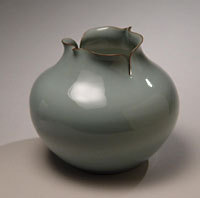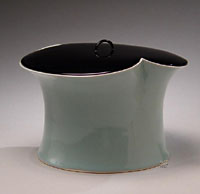|

Click here for
index to all
Yellin stories for
The Japan Times
LEARN MORE
Interview with
Kawase Shinobu
Interview with
Joan Mirviss
Japan Times
Story about
Joan Mirviss

What is
Celadon?

Yellin's gallery
sells pieces from
the kilns of Japan's
finest potters |
|
Asia Week Sees Debut Show
of a Famous Celadon Potter
By ROBERT YELLIN
for the Japan Times, March 30, 2005
|
|
Celadon Work
by Kawase Shinobu
Flower vase with tapered base
and flared pinched rim
Crackled flowered vase
with ovoid body and tsuru-kubi long neck, 1989, celadon bowl with double pinched rim; ribbed jar with wide mouth

Celadon vase in bulbous shape with pinched points and cut openings at its raised mouth

Mizusashi water jar
with pinched points
|
|
|
|
|
Asian art becomes the talk of the town each spring -- not just in Tokyo or Beijing -- but in New York City where its annual Asia Week is now in full sway. Exhibitions abound in the Big Apple with some of the world's top dealers offering their treasures to collectors who visit from around the world. Needless to say, Japanese art is well-represented in all genres.
What is a delight to see each year is the increase in awareness and interest in contemporary Japanese ceramic art as more and more private collectors and museums are acquiring top-level contemporary Japanese ceramic art. There are a few reasons behind this, being that fine antique works are getting harder and harder to acquire. A second is that information on what is happening today in the Japanese ceramic scene is more readily available in English, and collectors armed with knowledge feel more empowered and confident to purchase.
There are a few dealers who have offered new clay pieces alongside their more expensive antiques, more out of their own love of the medium than for any monetary gain. The premier New York dealer in this latter category is Joan Mirviss of Joan B. Mirviss Ltd (see www.mirviss.com).
For the International Asian Art Fair (see www.haughton.com), being held April 1-6 (2005) at The Seventh Regiment Armory Park Avenue on 67th Street, Mirviss will introduce the first-ever exhibition outside of Japan of the stunning celadon world of Kawase Shinobu.
Kawase (1950-) is a Kanagawa-based ceramic artist who is already a living legend for his remaking of what celadon can be. Celadon (called seiji in Japanese) is a reduction-fired glazed ware that originated in China during the Song Dynasty (960-1270) and thereafter spread quickly across Asia. Experts say that the best celadon the world has ever seen are from China's 12th-13th century Southern Song Dynasty -- pieces made by the court-sanctioned ceramists of the imperial kilns of Chiao-t'an. These wares are known as kuan (official) ware.
While shapes in seiji have traditionally been rigid -- being based on ancient bronzes -- Kawase creates forms that are organic and flowing. The way he forms the "lips" on pieces is particularly innovative, often using cracked or wavy lines.
In the exhibition pamphlet, Kawase writes: "By searching for the elusive color of Song celadon and stretching the aesthetic boundaries of Chinese traditional forms, the warm and serene beauty of this art emerges in the plasticity of the clay and the coolness of the glaze."
I was fortunate enough to catch up with his dealer, Joan Mirviss, for an e-mail interview and ask her about her connection with Kawase.
When was the first time you encountered Kawase's art?
At the "Japan Ceramics Today" exhibition that was held at the Museum of Natural History, Smithsonian Institution, Washington, D.C., in 1983. I went back to see the show twice and was permanently hooked on contemporary Japanese ceramics from that point on. In that show, there was an exquisite Kawase celadon inkstone from the collection of Tomo Kikuchi that was, and, to this day, remains one of my favorite works of art. The following year, when traveling to Japan in search of antique Japanese art, I was fortunate to be able to meet Kawase at his home in Oiso and enjoy a memorable meal together; this was the start of a lifelong relationship.
What must a work possess in order for you to exhibit it?
My criteria have always included an ability to master traditional techniques and recast those aesthetics with a unique, independent vision that is derived from older forms and methods yet is surprisingly modern and fresh. In my opinion, Kawase is a superstar in this regard. While there are many potters working in celadon, I do not feel that their work demonstrates the same level of mastery or obsession with perfection. The elegance of form drawn from antiquity but based on contemporary aesthetics remains unmatched.
What emotions do you sense in his work?
His works are amazingly sensual. Seeing them in photographs is woefully inadequate; they need to be held and caressed. Despite the coolness of his glazes, each vessel radiates a softness and warmth.
To have his first-ever exhibition shown overseas is quite a feat. The works from his personal collection form the core of the exhibition. How did this all come about?
After speaking with Kawase over several years about the possibility of bringing his first show outside Japan, I was literally speechless when I arrived in Oiso last September to look at the proposed new material. To my astonishment, he had concluded, after reflecting on possible new forms and designs for this initial New York venue, that it would be better to introduce his work to the West through a show of masterpieces all drawn from his personal collection. The show would therefore consist of works that he himself selected over the past 20 years. Consequently, this will be a unique opportunity for collectors and curators to see and perhaps acquire a true masterpiece by the master of celadon.
Do you think his works will be appreciated?
Beyond a shadow of a doubt. I've handled work by Kawase ever since 1983 and have placed numerous works in American museum collections such as the Metropolitan Museum of Art, St. Louis Art Museum and the Brooklyn Museum.
Do you see the interest in these institutions and private
collectors in contemporary Japanese ceramics growing?
Indeed the level of interest in this field has grown exponentially over the past seven years or so. There has additionally been an increase of serious interest among institutional buyers and this has stimulated further demand. At the IAAF, this year's loan show consists of the Museum of Art and Design collection of Asian contemporary ceramics.
Will you be showing any other contemporary
Japanese ceramic art at the IAAF?
Yes, besides the one-man Kawase show, I will also be exhibiting major ceramic works by Bizen's Kakurezaki Ryuichi and Harada Shuroku, Morino Taimei, Akiyama Yo and Miyashita Zenji from Kyoto, Wada Morihiro and Maeda Masahiro with their colorful patterned works, Kutani's Living National Treasure (LTN) Tokuda Yasokichi III, and Kaneta Masanao's masculine hagi, among others. In addition, I have arranged solo shows of Kondo Takahiro and Kishi Eiko -- both from Kyoto -- that are currently on view at the prestigious Barry Friedman Gallery in NYC.
The Japan Times: March 30, 2005
(C) All rights reserved
LEARN MORE
|